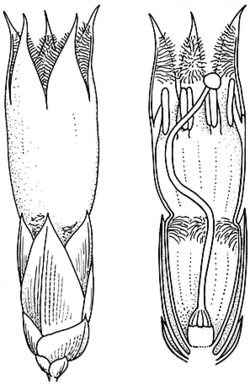| Genus Astroloma | Family Ericaceae
Subfamily Epacridoideae |

Description: Low shrubs, densely branched; branches scabrous to pubescent.
Leaves crowded, mainly narrowly ovate, lanceolate or linear, often discolorous with lower surface paler or glaucous, and with fine striate venation; acute to acuminate, usually with pungent tip; petiole short or absent.
Flowers axillary, solitary or 2 or 3 on short peduncles clothed with bracts; bracts several, grading in size to bracteoles, ovate to circular, glabrous or minutely pubescent and with ciliate margins. Sepals 5, often coloured, ovate, ciliate. Corolla tube cylindrical, with tufts of hair or hairy scales inside, or rarely ± glabrous; lobes valvate in bud, ovate, erect at least at the base, usually bearded inside. Stamens with filaments usually broad, flat, inserted at the throat; anthers obvious in throat. Nectary annular. Ovary usually 5-locular, with 1 ovule per loculus; style slender, equal to or longer than the corolla tube; stigma capitate.
Fruit a drupe with dry or slightly pulpy mesocarp.
Distribution and occurrence: World: 18 species, endemic Australia. Australia: N.S.W., Vic., Tas., S.A., W.A.
Text by J. M. Powell, except for groups with contributors listed
Taxon concept:
| | Key to the species | |
| 1 | Prostrate or ascending shrubs with more or less flat, erect to horizontally spreading leaves with toothed to ciliate margins; flowers bright to dark red with 5 tufts of hairs forming a ring inside below the middle; fruit 4.9–6 mm long | Astroloma humifusum |
| Erect or spreading shrub with convex erect leaves with entire margins; flowers red at base, yellow-green near apex, sparsely villous over the upper half inside; fruit 10–15 mm long | Astroloma pinifolium |
|


